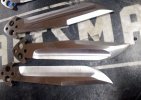jdm61
itinerant metal pounder
- Joined
- Aug 12, 2005
- Messages
- 47,357
So I am working on yet another 270 mm AEB-L suji. What I have been doing with these lately is grinding them down pretty thin and then working my way up to 65 µm gator belts. I then scrub them down with 320 grit EDM stones with occasional trips back to the 65 µm built to get rid of some of the stubborn 80 and 120 marks that I missed. Once I am done with that I go with 400 and 600 grit rhynowet paper And end up with what is essentially a pretty slick 400 grit hand rubbed finish. It obviously takes a bit less time then the thousand plus grit finish that I put on one of my W-2 knives or the 800 minimum I put on the Damascus blade before etching. But it’s still a bit of work and as I am not a big name who can ask for top dollar for anything like say the guys at Bloodroot Blades or Cut Brooklyn, I really need to think about laborsaving methods. At the same time I have seen some finishes on some of these previously mentioned expensive blades that I really don’t like all that much. Obvious belt finishes ground at an angle and such. So what do you guys think would be a minimum acceptable machine finish for lack of a better term and what else would you use to get it? I understand that the disadvantage of not doing the thing with the EDM stones is that I have to grind my edge down even thinner because I don’t get that last little kick from the stones so that I can just go straight over to 1000 grit Waterstone just at the edge. I appreciate the input











